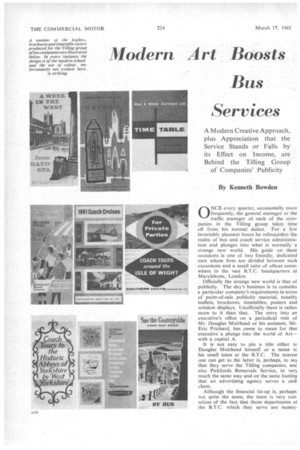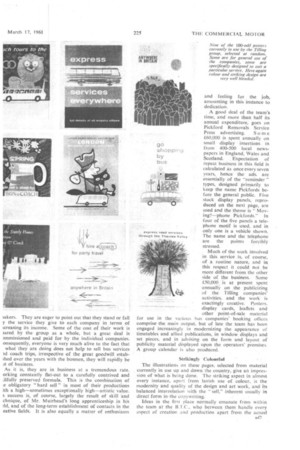Modern Art Boosts Bus Services
Page 80

Page 81

Page 82

If you've noticed an error in this article please click here to report it so we can fix it.
A Modern Creative Approach, plus Appreciation that the Service Stands or Falls by its Effect on Income, are Behind the Tilling Group of Companies' Publicity By Kenneth Bowden
ONCE every quarter, occasionally more frequently, the general manager or the traffic manager of each of the companies in the Tilling group takes time off from his normal duties. For a few invariably pleasant hours he relinquishes the realm of bus and coach service administration and plunges into what is normally a strange new world. His guide on these occasions is one of two friendly, dedicated men whose lives are divided between such excursions and a small suite of offices somewhere in the vast B.T.C. headquarters at Marylebone, London.
Officially the strange new world is that of publicity. The day's business is to consider a particular company's requirements in terms of point-of-sale publicity material, notably leaflets, brochures, timetables, posters and window displays. Unofficially there is rathet more to it than that. The entry into an executive's office on a periodical visit of Mr. Douglas Muirhead or his assistant, Mr. Eric Prichard, has come to mean for that executive a plunge into the world of Art— with a capital A.
It is not easy to pin a title either to Douglas Muirhead himself or a name tc his small team at the B.T.C. The nearesl one can get to the latter is, perhaps, to say that they serve the Tilling companies, and also Pickfords Removals Service, in very much the same way and on the same footing that an advertising agency serves a cash client.
Although the financial tie-up is, perhaps, not quite the same, the team is very conscious of the fact that those departments ol the B.T.C. which they serve are money. takers. They are eager to point out that they stand or fall y the service they give to each company in terms of tereasing its income. Some of the cost of their work is tared by the group as a whole, but a great deal is mmissioned and paid for by the individual companies. onsequently, everyone is very much alive to the fact that what they are doing does not help to sell bus services Id coach trips, irrespective of the great goodwill estab;hed over the years with the busmen, they will rapidly be it of business.
As it is, they are in business at a tremendous rate, orking constantly flat-out to a carefully contrived and :iIfully preserved formula. This is the combination of e obligatory "hard sell" in most of their productiOns ith a high—sometimes exceptionally high—artistic value. s success is, of course, largely the result of skill and chnique, of Mr. Muirhead's long apprenticeship in his and of the long-term establishment of contacts in the eative fields. It is also equally a matter of enthusiasm and feeling for the job, amounting in this instance to dedication.
A good deal of the team's time, and more than half its annual expenditure, goes on Pickford Removals Service Press advertising. Some £60,000 is spent annually on small display insertions in from 400-500 local newspapers in England, Wales and Scotland. , Expectation of repeat business in this field is calculated as once'every seven years, hence the ads. are essentially of the "reminder" types, designed primarily to keep the name Pickfords before the general public. Five stock display panels, reproduced on the next page, are used and the theme is "Moving?—phone Pickfords." In four of the five panels a telephone motif is used, and in only one is a vehicle shown. The name and the telephone are the points forcibly stressed. • . Much of the work involved in this service is, of course, of a routine nature, and -in this respect it could not , be more different from the other side of the business. Some £50,000 is at present spent
• annuallY on the publicizing of the Tilling companies' activities, and the work is exactingly creative. Posters, display cards, leaflets and other point-of-sale material for use in the various bus companies' booking offices compriser the main output, but of late the team has been engaged increasingly in modernizing the appearance of timetables and allied publications, in window displays and set pieces, and in advising on the form and layout of publicity material displayed upon the operators' premises. A group calendar is also produced.
Strikingly Colourful
The illustrations on these pages, selected from material currently in use up and down the country, give an impression of what is being done. The striking aspect in almost every instance, apart from lavish use of colour, is the modernity and quality of the design and art work, and its balanced interrelation with the "sell," inherent usually in direct form in.the copywriting.
Ideas in the first place normally emanate from within the team at the B.T.C'., who between them handle every aspect of creation and production apart from the actual 1347 art work and printing, or the physical construction of set pieces. This includes the "typography and copywriting. The idea, once conceived, is put to and discussed with an artist, and it is really connections in the purely artistic sphere which enable the team to achieve so much on, relative to specialist concerns, so little money.
From his earliest days as a publicist Mr. Muirhead not only encouraged young, up-and-coming artists themselves, but, what really matters, has done it by willingness to accept their ideas and forms as expressed in paint. Very often this has meant a departure from his own initial concepts, and not infrequently has resulted in a piece of work some years ahead of its time, particularly with regard to posters. In the long run the policy has paid off tremendously. The team today has on its books not only the young artists of 1961, but those of previous years who are now firmly established.
A Big Appeal • Consequent upon this policy is the modernity running through the whole range of productions, particularly in the bold use of colour and the near-abstract design of many of the posters and timetable and leaflet covers. It is a modernity in keeping with the general trend of most publicity and advertising material, with which all industries are virtually forced by the conditioning of the public to keep abreast, irrespective of individual tastes. That it is a modernity which appeals to the busand coach-travelling public is proved by the unending demand for both stock and special area or seasonal posters and display material from operating companies.
At the moment the organization produces around 110 posters a year—over two a week—of general and specific types, many of them individually tailored to a company or even to a particular service. That this output will increase there seems little doubt, and while it is keyed directly to the overall and individual revenue of the Tilling companies it can represent only healthy expansion.
The impression may have been given that Douglas Muirhead is more of an artist than a busman, and this is undoubtedly true. He and his lieutenants have no pretence to expert knowledge of how to operate a bus company. But the creative talent is not the only one. To build up the excellent relations now existing trtween his team and the company executives and, above all, in a short time to revolutionize the Tilling group publicity material as he has done, have required employing some of the arts of the psychologist.
Not all busmen are artistically inclined. Those with many years in the industry might, quite naturally, have grown fond of the stereotyped no-nonsense poster, the timetable cover full of old-fashioned type with, perhaps, a squiggly decoration in pea green. It is no secret that some of them at first did not over-warmly welcome a man in a bow tie, down from London with a headful of colour and a pocketful of abstracts.
Part of Douglas Muirhead's stock-in-trade over the year has come to be an artist's big black bag. It goes with hirr everywhere. Inside are examples of work done for mosi of the companies, currently and in the past. Quietly, in the course of conversation, they are arrayed, past, present an future. And, as often as not, as Mr. Muirhead is saying "Well, this is what you've been using up until now—' the company man's eye will alight on the latest ultra. modern piece done for one of his associates. "By Jingo that's good," he will say. "Can't we have something lik( that?"
The battle, if ever there was one, is won.




































































































































